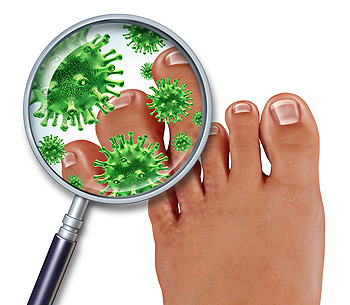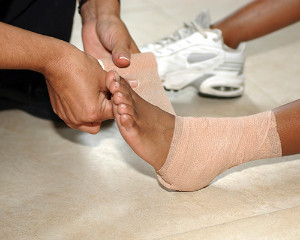Blog
An Overview of Plantar Fasciitis
The plantar fascia is a rigid, thick tissue that con nects the heel bone to the toes. Plantar fasciitis occurs when the plantar fascia becomes inflamed. Causes include rapid weight gain, excessive exercise, flat feet, improper footwear and prolonged standing. The most common symptoms are heel swelling and/or stiffness, sharp or dull pain at the bottom of the foot and pain that worsens with the more weight that is put on it. The treatment options for plantar fasciitis are fairly basic. They are rest, applying ice, stretching and muscle strengthening exercises. Strategies that can be used to prevent plantar fasciitis from recurring are losing weight, wearing supportive, well-cushioned footwear, regularly performing plantar fascia stretching exercises and switching to low-impact forms of exercise such as swimming and stationary cycling. If you are experiencing any symptoms of plantar fasciitis, it is advised to consult with a podiatrist for the best treatment options.
nects the heel bone to the toes. Plantar fasciitis occurs when the plantar fascia becomes inflamed. Causes include rapid weight gain, excessive exercise, flat feet, improper footwear and prolonged standing. The most common symptoms are heel swelling and/or stiffness, sharp or dull pain at the bottom of the foot and pain that worsens with the more weight that is put on it. The treatment options for plantar fasciitis are fairly basic. They are rest, applying ice, stretching and muscle strengthening exercises. Strategies that can be used to prevent plantar fasciitis from recurring are losing weight, wearing supportive, well-cushioned footwear, regularly performing plantar fascia stretching exercises and switching to low-impact forms of exercise such as swimming and stationary cycling. If you are experiencing any symptoms of plantar fasciitis, it is advised to consult with a podiatrist for the best treatment options.
Plantar fasciitis is a common foot condition that is often caused by a strain injury. If you are experiencing heel pain or symptoms of plantar fasciitis, contact Shaun J. Limon, DPM and Lisa Griffith-Limon, DPM from Limons Foot & Ankle Care. Our doctors can provide the care you need to keep you pain-free and on your feet.
What Is Plantar Fasciitis?
Plantar fasciitis is one of the most common causes of heel pain. The plantar fascia is a ligament that connects your heel to the front of your foot. When this ligament becomes inflamed, plantar fasciitis is the result. If you have plantar fasciitis you will have a stabbing pain that usually occurs with your first steps in the morning. As the day progresses and you walk around more, this pain will start to disappear, but it will return after long periods of standing or sitting.
What Causes Plantar Fasciitis?
- Excessive running
- Having high arches in your feet
- Other foot issues such as flat feet
- Pregnancy (due to the sudden weight gain)
- Being on your feet very often
There are some risk factors that may make you more likely to develop plantar fasciitis compared to others. The condition most commonly affects adults between the ages of 40 and 60. It also tends to affect people who are obese because the extra pounds result in extra stress being placed on the plantar fascia.
Prevention
- Take good care of your feet – Wear shoes that have good arch support and heel cushioning.
- Maintain a healthy weight
- If you are a runner, alternate running with other sports that won’t cause heel pain
There are a variety of treatment options available for plantar fasciitis along with the pain that accompanies it. Additionally, physical therapy is a very important component in the treatment process. It is important that you meet with your podiatrist to determine which treatment option is best for you.
If you have any questions, please feel free to contact our offices located in Bradenton and Lakewood Ranch, FL . We offer the newest diagnostic and treatment technologies for all your foot care needs.
Read more about Plantar Fasciitis
Ligaments and Ankle Sprains
There are several ways ankle sprains can occur. It happens once the supporting ligaments become injured when the ankle is twisted, possibly resulting from stepping off a curb unexpectedly. The symptoms that are often associated with sprained ankles can include pain and discomfort surrounding the affected ankle, and the ankle may appear bruised and swollen. Many patients find it difficult to walk, and may have to use crutches. After a proper diagnosis is performed, which consists of having an X-ray taken, the treatment process can begin. It is important to elevate the ankle, as this may help to reduce any existing swelling. If you feel you have sprained your ankle, please consider scheduling a consultation with a podiatrist who can guide you toward beginning the proper treatment.
Ankle sprains are common but need immediate attention. If you need your feet checked, contact Shaun J. Limon, DPM and Lisa Griffith-Limon, DPM from Limons Foot & Ankle Care. Our doctors can provide the care you need to keep you pain-free and on your feet.
How Does an Ankle Sprain Occur?
Ankle sprains take place when the ligaments in your ankle are torn or stretched beyond their limits. There are multiple ways that the ankle can become injured, including twisting or rolling over onto your ankle, putting undue stress on it, or causing trauma to the ankle itself.
What Are the Symptoms?
- Mild to moderate bruising
- Limited mobility
- Swelling
- Discoloration of the skin (depending on severity)
Preventing a Sprain
- Wearing appropriate shoes for the occasion
- Stretching before exercises and sports
- Knowing your limits
Treatment of a Sprain
Treatment of a sprain depends on the severity. Many times, people are told to rest and remain off their feet completely, while others are given an air cast. If the sprain is very severe, surgery may be required.
If you have suffered an ankle sprain previously, you may want to consider additional support such as a brace and regular exercises to strengthen the ankle.
If you have any questions please feel free to contact our offices located in Bradenton and Lakewood Ranch, FL . We offer the newest diagnostic and treatment technologies for all your foot and ankle needs.
Read more about Ankle SprainsReminder: When Was the Last Time...?
Laser Treatment of Toenail Fungus
If you have toenail fungus, laser tr eatment may be the answer. Some symptoms of fungal nails include yellow, white, or brown nail discoloration, thickening of the nail or change in texture, change in shape of the nail and any flaky debris that is present under or on the nail. The FDA has approved a few different types of laser devices for the treatment of onychomycosis, which is another name for a fungal nail infection. Some of the laser devices include PinPointe Footlaser, GenesisPlus and Noveon. These laser devices kill off the nail fungus by emitting pulses of energy that impart heat to the infected tissue on the nail. When the fungus on the nail absorbs the heat from the laser treatment, it will begin to die off. While some patients will have success with a single laser treatment, additional treatments can be prescribed depending on the results. This most often depends on the type of laser treatment being utilized. Laser treatment can be a more expensive method, but it also happens to be the most efficient. If you are dealing with toenail fungus and are interested in laser treatment, consult with a podiatrist.
eatment may be the answer. Some symptoms of fungal nails include yellow, white, or brown nail discoloration, thickening of the nail or change in texture, change in shape of the nail and any flaky debris that is present under or on the nail. The FDA has approved a few different types of laser devices for the treatment of onychomycosis, which is another name for a fungal nail infection. Some of the laser devices include PinPointe Footlaser, GenesisPlus and Noveon. These laser devices kill off the nail fungus by emitting pulses of energy that impart heat to the infected tissue on the nail. When the fungus on the nail absorbs the heat from the laser treatment, it will begin to die off. While some patients will have success with a single laser treatment, additional treatments can be prescribed depending on the results. This most often depends on the type of laser treatment being utilized. Laser treatment can be a more expensive method, but it also happens to be the most efficient. If you are dealing with toenail fungus and are interested in laser treatment, consult with a podiatrist.
Laser treatment can be an effective way to get rid of toenail fungus. If you have any questions about laser treatment, consult with Shaun J. Limon, DPM and Lisa Griffith-Limon, DPM from Limons Foot & Ankle Care. Our doctors will assess your condition and provide you with quality treatment for fungal nails.
What Are Toenail Fungal Infections?
Onychomycosis, or fungal infection of the nail, is a relatively common and non-serious condition. Around 10 percent of U.S. citizens are afflicted with fungal nails. Common forms of fungus that infect the nail include dermatophytes, yeasts, and molds.
Symptoms of Toenail Fungal Infections Include:
- Nail thickening
- Brittleness of the nail
- Discoloration of the nail
Diagnosis for Fungal Nails
Fungal infections are diagnosed by fungal culture and microscopy. This will rule out any other conditions such as nail trauma, psoriasis, lichen planus, and onychogryphosis.
What Is Laser Treatment?
Laser treatment is a non-invasive, safe, quick, and painless procedure that uses the heat from a laser to kill fungus in the nail. Each infected nail is targeted with a laser for several minutes. The treatment is usually utilized several different times over a select period. During this time, a podiatrist will keep an eye on the infection.
If you have any questions, please feel free to contact our offices located in Bradenton and Lakewood Ranch, FL . We offer the newest diagnostic and treatment technologies for all your foot care needs.
Read more about Laser Treatment for Fungal NailsSports Foot and Ankle Injuries
Sports are physical activities, and with all physical activities co mes the possibility of injury at some point. The parts of the body that are most prone to injury from sports are the foot and ankle. The most common foot and ankle injuries endured from sports are sprains, tendonitis, fractures and contusions. Other sports related injuries to the ankles and feet include strains, plantar fasciitis, tears in foot and ankle tendons as well as chronic ankle instability. If you are active in sports, it is recommended to see a podiatrist in order to ensure that the feet and ankles are in good shape.
mes the possibility of injury at some point. The parts of the body that are most prone to injury from sports are the foot and ankle. The most common foot and ankle injuries endured from sports are sprains, tendonitis, fractures and contusions. Other sports related injuries to the ankles and feet include strains, plantar fasciitis, tears in foot and ankle tendons as well as chronic ankle instability. If you are active in sports, it is recommended to see a podiatrist in order to ensure that the feet and ankles are in good shape.
Sports related foot and ankle injuries require proper treatment before players can go back to their regular routines. For more information, contact Shaun J. Limon, DPM and Lisa Griffith-Limon, DPM of Limons Foot & Ankle Care. Our doctors can provide the care you need to keep you pain-free and on your feet.
Sports Related Foot and Ankle Injuries
Foot and ankle injuries are a common occurrence when it comes to athletes of any sport. While many athletes dismiss the initial aches and pains, the truth is that ignoring potential foot and ankle injuries can lead to serious problems. As athletes continue to place pressure and strain the area further, a mild injury can turn into something as serious as a rupture and may lead to a permanent disability. There are many factors that contribute to sports related foot and ankle injuries, which include failure to warm up properly, not providing support or wearing bad footwear. Common injuries and conditions athletes face, including:
- Plantar Fasciitis
- Plantar Fasciosis
- Achilles Tendinitis
- Achilles Tendon Rupture
- Ankle Sprains
Sports related injuries are commonly treated using the RICE method. This includes rest, applying ice to the injured area, compression and elevating the ankle. More serious sprains and injuries may require surgery, which could include arthroscopic and reconstructive surgery. Rehabilitation and therapy may also be required in order to get any recovering athlete to become fully functional again. Any unusual aches and pains an athlete sustains must be evaluated by a licensed, reputable medical professional.
If you have any questions please feel free to contact our offices located in Bradenton and Lakewood Ranch, FL . We offer the newest diagnostic and treatment technologies for all your foot and ankle needs.
Read more about Sports Related Foot and Ankle InjuriesWhy Live with Pain and Numbness in Your Feet?
What Causes an Ingrown Toenail to Develop?
 If you notice the skin on the outside of your big toe appears to be red and swollen, you may have what is referred to as an ingrown toenail. It happens as a result of the toenail growing into the skin, which is often a painful and uncomfortable condition. There are several reasons why ingrown toenails may develop. These can include wearing shoes that do not have adequate room for the toes to move freely in, improperly trimming the toenails, or from sustaining a foot injury. Diabetic patients may find it beneficial to have their toenails trimmed correctly, as this can help to prevent possible toenail infections from developing. Additionally, it is suggested that the feet are kept dry and clean, to diminish the chances of getting an ingrown toenail. The toe and the surrounding skin may feel better as they are soaked in warm water several times throughout the day. If you are afflicted with an ingrown toenail, it is suggested that you seek the counsel of a podiatrist who can diagnosis and treat this condition.
If you notice the skin on the outside of your big toe appears to be red and swollen, you may have what is referred to as an ingrown toenail. It happens as a result of the toenail growing into the skin, which is often a painful and uncomfortable condition. There are several reasons why ingrown toenails may develop. These can include wearing shoes that do not have adequate room for the toes to move freely in, improperly trimming the toenails, or from sustaining a foot injury. Diabetic patients may find it beneficial to have their toenails trimmed correctly, as this can help to prevent possible toenail infections from developing. Additionally, it is suggested that the feet are kept dry and clean, to diminish the chances of getting an ingrown toenail. The toe and the surrounding skin may feel better as they are soaked in warm water several times throughout the day. If you are afflicted with an ingrown toenail, it is suggested that you seek the counsel of a podiatrist who can diagnosis and treat this condition.
Ingrown toenails may initially present themselves as a minor discomfort, but they may progress into an infection in the skin without proper treatment. For more information about ingrown toenails, contact Shaun J. Limon, DPM and Lisa Griffith-Limon, DPM of Limons Foot & Ankle Care. Our doctors can provide the care you need to keep you pain-free and on your feet.
Ingrown Toenails
Ingrown toenails are caused when the corner or side of a toenail grows into the soft flesh surrounding it. They often result in redness, swelling, pain, and in some cases, infection. This condition typically affects the big toe and may recur if it is not treated properly.
Causes
- Improper toenail trimming
- Genetics
- Improper shoe fitting
- Injury from pedicures or nail picking
- Abnormal gait
- Poor hygiene
You are more likely to develop an ingrown toenail if you are obese, have diabetes, arthritis, or have any fungal infection in your nails. Additionally, people who have foot or toe deformities are at a higher risk of developing an ingrown toenail.
Symptoms
Some symptoms of ingrown toenails are redness, swelling, and pain. In rare cases, there may be a yellowish drainage coming from the nail.
Treatment
Ignoring an ingrown toenail can have serious complications. Infections of the nail border can progress to a deeper soft-tissue infection, which can then turn into a bone infection. You should always speak with your podiatrist if you suspect you have an ingrown toenail, especially if you have diabetes or poor circulation.
If you have any questions, please feel free to contact our offices located in Bradenton and Lakewood Ranch, FL . We offer the newest diagnostic and treatment technologies for all your foot care needs.
Read more about Ingrown Toenail CareIs Foot or Ankle Surgery the Correct Choice?
 The choice to receive foot or ankle surgery depends on the person and situation. Some conditions where surgery could be an option include bunions, ankle arthritis and plantar fasciitis. Your doctor would most likely see how you respond to other treatments first, such as drugs or special footwear. They would also evaluate your needs and the symptoms of the ailment. There are advantages and disadvantages to receiving surgery. Surgery may provide long-lasting relief, better mobility and comfort. However, some surgeries cause more complications. You may not be able to use your foot normally for a while, and replacement joints may not work as well as natural joints. If you have a foot or ankle condition, and think you may need surgery, it is recommended that you speak with a podiatrist as soon as possible.
The choice to receive foot or ankle surgery depends on the person and situation. Some conditions where surgery could be an option include bunions, ankle arthritis and plantar fasciitis. Your doctor would most likely see how you respond to other treatments first, such as drugs or special footwear. They would also evaluate your needs and the symptoms of the ailment. There are advantages and disadvantages to receiving surgery. Surgery may provide long-lasting relief, better mobility and comfort. However, some surgeries cause more complications. You may not be able to use your foot normally for a while, and replacement joints may not work as well as natural joints. If you have a foot or ankle condition, and think you may need surgery, it is recommended that you speak with a podiatrist as soon as possible.
Foot surgery is sometimes necessary to treat a foot ailment. To learn more, contact Shaun J. Limon, DPM and Lisa Griffith-Limon, DPM of Limons Foot & Ankle Care. Our doctors will assist you with all of your foot and ankle needs.
When Is Surgery Necessary?
Foot and ankle surgery is generally reserved for cases in which less invasive, conservative procedures have failed to alleviate the problem. Some of the cases in which surgery may be necessary include:
- Removing foot deformities like bunions and bone spurs
- Severe arthritis that has caused bone issues
- Cosmetic reconstruction
What Types of Surgery Are There?
The type of surgery you receive will depend on the nature of the problem you have. Some of the possible surgeries include:
- Bunionectomy for painful bunions
- Surgical fusion for realignment of bones
- Neuropathy decompression surgery to treat nerve damage
Benefits of Surgery
Although surgery is usually a last resort, it can provide more complete pain relief compared to non-surgical methods and may allow you to finally resume full activity.
Surgical techniques have also become increasingly sophisticated. Techniques like endoscopic surgery allow for smaller incisions and faster recovery times.
If you have any questions please feel free to contact our offices located in Bradenton and Lakewood Ranch, FL . We offer the newest diagnostic and treatment technologies for all your foot and ankle needs.
Read more about Foot SurgeryPlantar Warts Can Be Treated!
Preventing Plantar Hyperhidrosis
 Plantar hyperhidrosis is the condition of excessive feet sweating. Hyperhidrosis can be extremely uncomfortable. There are a few measures to take in order to prevent uncontrolled sweating. One method is to log when sweating episodes occur. You may begin to notice that you sweat more when you are in specific situations or eat certain types of foods. Also, be sure to wear the correct socks. You should have different socks for the seasons and for various types of athletic activities. In addition to having the correct socks, choose shoes that are made of lightweight fabrics, such as canvas or leather. Another method is to use antifungal powder or cornstarch on your feet. You may want to apply an antiperspirant to the feet once or twice per week, as well. Finally, stay hydrated. Proper hydration can reduce sweating throughout the whole body. If you believe you may be experiencing plantar hyperhidrosis, be sure to contact a podiatrist who can help treat the affliction.
Plantar hyperhidrosis is the condition of excessive feet sweating. Hyperhidrosis can be extremely uncomfortable. There are a few measures to take in order to prevent uncontrolled sweating. One method is to log when sweating episodes occur. You may begin to notice that you sweat more when you are in specific situations or eat certain types of foods. Also, be sure to wear the correct socks. You should have different socks for the seasons and for various types of athletic activities. In addition to having the correct socks, choose shoes that are made of lightweight fabrics, such as canvas or leather. Another method is to use antifungal powder or cornstarch on your feet. You may want to apply an antiperspirant to the feet once or twice per week, as well. Finally, stay hydrated. Proper hydration can reduce sweating throughout the whole body. If you believe you may be experiencing plantar hyperhidrosis, be sure to contact a podiatrist who can help treat the affliction.
If you are suffering from hyperhidrosis contact Shaun J. Limon, DPM and Lisa Griffith-Limon, DPM of Limons Foot & Ankle Care. Our doctors can provide the care you need to attend to all of your foot and ankle needs.
Hyperhidrosis of the Feet
Hyperhidrosis is a rare disorder that can cause people to have excessive sweating of their feet. This can usually occur all on its own without rigorous activity involved. People who suffer from hyperhidrosis may also experience sweaty palms.
Although it is said that sweating is a healthy process meant to cool down the body temperature and to maintain a proper internal temperature, hyperhidrosis may prove to be a huge hindrance on a person’s everyday life.
Plantar hyperhidrosis is considered to be the main form of hyperhidrosis. Secondary hyperhidrosis can refer to sweating that occurs in areas other than the feet or hands and armpits. Often this may be a sign of it being related to another medical condition such as menopause, hyperthyroidism and even Parkinson’s disease.
In order to alleviate this condition, it is important to see your doctor so that they may prescribe the necessary medications so that you can begin to live a normal life again. If this is left untreated, it is said that it will persist throughout an individual’s life.
A last resort approach would be surgery, but it is best to speak with your doctor to find out what may be the best treatment for you.
If you have any questions please feel free to contact our offices located in Bradenton and Lakewood Ranch, FL . We offer the newest diagnostic and treatment technologies for all your foot and ankle needs.
Read more about Hyperhidrosis of the FeetMore...
Possible Causes of Hammertoe
 The medical condition that is referred to as hammertoe is considered to be a deformity in the middle toes. It may develop as a result of wearing shoes that do not fit correctly, or it can occur from genetic factors. When the toes become cramped in the shoe, the middle toe bends to resemble the shape of a hammer. It can overlap onto the toe next to it, and consistent friction can cause a callus to develop. Additionally, some patients may experience pain in the ball of the foot, which is a result of chronic stress the foot endures. Mild relief may be found when soft padding is inserted in the shoe. For severe cases of hammertoe, surgery could be a viable option to consider in order to permanently straighten the toes. If you notice you are developing hammertoe, it is advised to seek the counsel of a podiatrist who can provide you with the treatment that is best for you.
The medical condition that is referred to as hammertoe is considered to be a deformity in the middle toes. It may develop as a result of wearing shoes that do not fit correctly, or it can occur from genetic factors. When the toes become cramped in the shoe, the middle toe bends to resemble the shape of a hammer. It can overlap onto the toe next to it, and consistent friction can cause a callus to develop. Additionally, some patients may experience pain in the ball of the foot, which is a result of chronic stress the foot endures. Mild relief may be found when soft padding is inserted in the shoe. For severe cases of hammertoe, surgery could be a viable option to consider in order to permanently straighten the toes. If you notice you are developing hammertoe, it is advised to seek the counsel of a podiatrist who can provide you with the treatment that is best for you.
Hammertoe
Hammertoes can be a painful condition to live with. For more information, contact Shaun J. Limon, DPM and Lisa Griffith-Limon, DPM from Limons Foot & Ankle Care. Our doctors will answer any of your foot- and ankle-related questions.
Hammertoe is a foot deformity that affects the joints of the second, third, fourth, or fifth toes of your feet. It is a painful foot condition in which these toes curl and arch up, which can often lead to pain when wearing footwear.
Symptoms
- Pain in the affected toes
- Development of corns or calluses due to friction
- Inflammation
- Redness
- Contracture of the toes
Causes
Genetics – People who are genetically predisposed to hammertoe are often more susceptible
Arthritis – Because arthritis affects the joints in your toes, further deformities stemming from arthritis can occur
Trauma – Direct trauma to the toes could potentially lead to hammertoe
Ill-fitting shoes – Undue pressure on the front of the toes from ill-fitting shoes can potentially lead to the development of hammertoe
Treatment
Orthotics – Custom made inserts can be used to help relieve pressure placed on the toes and therefore relieve some of the pain associated with it
Medications – Oral medications such as anti-inflammatories or NSAIDs could be used to treat the pain and inflammation hammertoes causes. Injections of corticosteroids are also sometimes used
Surgery – In more severe cases where the hammertoes have become more rigid, foot surgery is a potential option
If you have any questions please contact our offices located in Bradenton and Lakewood Ranch, FL . We offer the newest diagnostic and treatment technologies for all your foot and ankle needs.
Read more about HammertoeArthritis Can Cause Pain in the Feet and Ankles
Possible Causes of Cracked Heels
 The skin condition that is known as cracked heels can often cause pain and discomfort. It occurs as a result of small cuts that develop in the heels of the feet, and may worsen if treatment is not promptly started. The heels endure the weight of the body, and this condition may easily form if the skin is dry, or if there is standing that is done for the majority of the day. Obesity may be a contributing cause to the onset of cracked heels, in addition to not consuming adequate amounts of vitamins and minerals. Mild relief may be obtained when the feet are soaked in warm water, followed by using a good moisturizer. It may be beneficial to choose shoes that provide adequate support in the heel area, and to avoid wearing shoes that have an open back. If you have developed cracked heels, it is advised that you schedule a consultation with a podiatrist who can properly treat this condition.
The skin condition that is known as cracked heels can often cause pain and discomfort. It occurs as a result of small cuts that develop in the heels of the feet, and may worsen if treatment is not promptly started. The heels endure the weight of the body, and this condition may easily form if the skin is dry, or if there is standing that is done for the majority of the day. Obesity may be a contributing cause to the onset of cracked heels, in addition to not consuming adequate amounts of vitamins and minerals. Mild relief may be obtained when the feet are soaked in warm water, followed by using a good moisturizer. It may be beneficial to choose shoes that provide adequate support in the heel area, and to avoid wearing shoes that have an open back. If you have developed cracked heels, it is advised that you schedule a consultation with a podiatrist who can properly treat this condition.
Cracked heels are unsightly and can cause further damage to your shoes and feet. If you have any concerns, contact Shaun J. Limon, DPM and Lisa Griffith-Limon, DPM from Limons Foot & Ankle Care. Our doctors can provide the care you need to keep you pain-free and on your feet.
Cracked Heels
Cracked heels appear unappealing and can make it harder for you walk around in sandals. Aside from looking unpleasant, cracked heels can also tear stockings, socks, and wear out your shoes. There are several methods to help restore a cracked heel and prevent further damage.
How Do You Get Them?
Dry skin is the number one culprit in creating cracked heels. Many athletes, walkers, joggers, and even swimmers suffer from cracked heels. Age and skin oil production play a role to getting cracked heels as well.
Promote Healing
Over the counter medicines can help, especially for those that need instant relief or who suffer from chronic dry feet.
Wear Socks – Wearing socks with medicated creams helps lock in moisture.
Moisturizers – Applying both day and night will help alleviate dryness which causes cracking.
Pumice Stones – These exfoliate and remove dead skin, which allows for smoother moisturizer application and better absorption into the skin.
Change in Diet
Eating healthy with a well-balanced diet will give the skin a fresh and radiant look. Your body responds to the kinds of food you ingest. Omega-3 fatty acids and zinc supplements can also revitalize skin tissue.
Most importantly, seek professional help if unsure how to proceed in treating cracked heels. A podiatrist will help you with any questions or information needed.
If you have any questions, please feel free to contact our offices located in Bradenton and Lakewood Ranch, FL . We offer the newest diagnostic and treatment technologies for all your foot care needs.
Read more about Solutions for Cracked HeelsFlip Flops and Foot Health
 Many people enjoy the simplicity of wearing flip flops. They are easy to slip into, which makes them a desirable shoe to wear. Despite their popularity, research has indicated they can be harmful to the feet. The arch is typically absent in this type of shoe, which may cause pain in the feet and ankles. Additionally, flip flops lack shock absorption, and there is minimal cushioning in the heel area. Many people also have to curl their toes which helps to provide stability in these shoes, and this may change the way you walk. It is beneficial wear shoes that have a strap on the back, which aids in supporting the foot. If you would like additional information about how flip flops affect the feet, it is suggested that you consult with a podiatrist.
Many people enjoy the simplicity of wearing flip flops. They are easy to slip into, which makes them a desirable shoe to wear. Despite their popularity, research has indicated they can be harmful to the feet. The arch is typically absent in this type of shoe, which may cause pain in the feet and ankles. Additionally, flip flops lack shock absorption, and there is minimal cushioning in the heel area. Many people also have to curl their toes which helps to provide stability in these shoes, and this may change the way you walk. It is beneficial wear shoes that have a strap on the back, which aids in supporting the foot. If you would like additional information about how flip flops affect the feet, it is suggested that you consult with a podiatrist.
Flip-flops are not always the best choice of footwear. If you have any concerns about your feet or ankles, contact Shaun J. Limon, DPM and Lisa Griffith-Limon, DPM from Limons Foot & Ankle Care. Our doctors will assist you with all of your foot and ankle needs.
Flip-Flops and Feet
When the weather starts warming up, people enjoy wearing flip-flops. Flip-flops are comfortable, stylish, and easy to slip on and off; they're perfect for any summer beach goer. However, these shoes can cause harm to the feet.
How Can Flip-Flops Affect Me Long-Term?
- Ankle problems
- Hip problems
- Lower back problems
- Pain in the balls of the feet
- Problems with foot arches
- Changes in the way you walk
Are There Injuries Associated with Flip-Flops?
Yes. Since flip-flops are relatively weak and do not provide the same amount of support as sneakers, people who wear flip-flops regularly are more susceptible to injuries. On top of that, the open nature of the shoe makes your feet more prone to other problems, such as cuts and even infections. Common injuries and ailments include:
- Sprained ankles
- Blisters
- Infections
- Cuts and Scrapes
I like Wearing Flip-Flops. Are There Safe Alternatives?
When buying flip-flops, try to find ones that have sturdy soles and that are made of high-quality materials that will support for your feet. These flip-flops will cost more but will also last longer as a result.
If you have any questions please feel free to contact our offices located in Bradenton and Lakewood Ranch, FL . We offer the newest diagnostic and treatment technologies for all your foot and ankle needs.
Read more about Flip Flops and Feet




